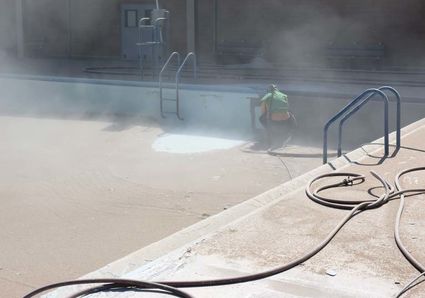Refurbishing of Mankato swimming pool making progress
October 1, 2020

Dust fills the air as a workman sandblasts a portion of the Mankato swimming pool. The Dane G. Hansen Foundation has helped fund the project.
Did you know that the Mankato swimming pool was built in 1955? It was one of the first all metal pools in the region. The Mankato swimming pool is an icon for the community and offers a refreshing outing during the summer months. Also, it allows individuals to learn how to swim and the public to have a place to exercise. There is much history with the Mankato pool. Some of the current Mankato council members were lifeguards at the pool. The pool has been utilized by people all over the county and some outside the county.
To keep the pool for years to come the city applied for a grant through the Dane G. Hansen Foundation for some much-needed maintenance on the pool. The thick coating was popping up in places and was becoming unsafe. City staff have been diligent keeping the pool safe over the years. However, it got to the point where the coating needed to come off. Work is now under way to sandblast the pool giving it a facelift and new coating. According to the contractor, it will last for another 15 to 20 years without the need to add any additional coatings. Without the Dane G. Hansen Foundation, this project and many other projects could not happen. Dane Hansen gives new life and hope to the communities of north west Kansas by improving the way of life for citizens and attracting new growth. The City of Mankato is appreciative of the generosity and assistance the Dane G. Hansen Foundation has provided.
----
The first public pool was installed at Brookline, Mass. more than 125 years agao. Public pools were preceded by public baths which had been around since the ancient Greeks and Romans. San Francisco had the famous Sutro baths in the late 19th century. Public bathhouses in New York City were an attempt to improve the personal hygiene habits of the crowded tenements.
Private swimming pools remained the domain of the well-to-do. By the 1930s, hotels began to incorporate swimming pools into their selection of guest amenities.
Public pools began to be installed in greater numbers across the country as an attempt to offer relief from the summer heat in those pre-air conditioning days. Many of these pools were primitive affairs. Some were only excavated dirt ponds. Others were concrete with no filtration system. When the water was dirty, the pool was simply emptied and refilled. The concrete construction method was labor intensive. Laborers installed rebar or wire mesh on the wall. Concrete was dumped on the pool floor. Workers then hand-packed the concrete onto the walls.
These earlier pools were often the subject of experimental methods. wood, steel and stainless steel walls, concrete with vinyl lining were among the methods used.
The post World War ll years saw a boom in both municipal and private pool building. Many of the returning servicemen had learned to swim. The newly emergent middle class had expendable funds. As the migration to the suburbs swelled in numbers so did the number of private and public pools.
Concrete, or more specifically, gunite or shotcrete, became the material of choice. Traditional concrete pools required forms, made of wood or metal, which were filled with concrete. When the concrete had set, the forms were removed. This was a labor intensive method and expensive.
Gunite, or shotcrete, is concrete which is applied through a high-pressure gun. It adheres to curved surfaces with ease and requires none of the expensive forms. It was named gunite by its inventor, Clay Akeley in 1909. The exingencies of WW ll resulted in the invention of the continuous feed method of delivering the product. The introduction of a wet mix process cemented the method as the preferred means of building in-ground pools. The name was officially changed to shotcrete in 1951.
Shotcrete pools are formed by using a framework grid made of rebar. The shotcrete, a mixture of water, sand and cement is then sprayed onto the grid. The product attaches and adheres to the cage. The flexibility of the grid allows for a variety of forms to be designed. The majority of pools, private and public, installed after the mid-50s, are of shotcrete construction.
Stainless steel was another popular building material. It was easy to bend and light weight. Pools could be assembled off site. They were then delivered to the desired location and installed in the pre-dug excavation. The sell offered flexibility for design. It was flexible and soft enough to be bent. The steel pools required little cleaning because of its smooth, non-porous surface. It inhibits bacteria from growing. Think of all the stainless steel in commercial and home kitchens. The material adapts well to any environment including extreme fluctuations in temperature. It has a life span measured in decades. When properly maintained, stainless steel will endure for years. There are stainless steel pools installed in the 1930s which are still in use. Rusting is not an issue because of the chromium which comprises part of the steel.
The Mankato pool was installed in 1955. When the current project is complete, the pool will have an extended life.
The one barrier to stainless steel is initial cost. It is higher than a concrete or shotcrete pool. The investment pays off over the years with negligible maintenance costs and durability. Stainless steel pools are now back in fashion. They are seen as environmentally friendly and low maintenance.
Mankato is again at the forefront of current trends with its 65-year old pool. Everything old is new again as the saying goes.















Reader Comments(0)